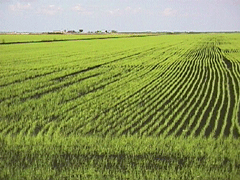Rice and... Arsenic?
Air Date: Week of March 23, 2007

A rice field in the southern U.S. (Courtesy of USGS)
A new study shows high levels of arsenic in rice grown in the American South. Rice is often grown in former cotton fields, where arsenic was long used as a pesticide. Living on Earth speaks with Professor Andrew Meharg of the University of Aberdeen, Scotland, who conducted the study.
Transcript
GELLERMAN: In states where cotton was once king, today rice reigns supreme. Consumption of rice in the U.S. has doubled over the last 25 years, and eighty percent of the rice grown here comes from states in the South Central part of the country. A lot of it is grown in former cotton fields. And when cotton was grown there, a lot of these fields were treated with pesticides that contained arsenic.
Dr. Andrew Meharg is a bio-geo-chemist at the University of Aberdeen in Scotland and an expert on arsenic in the environment. He investigated rice from these fields and he found that it contains unusually high levels of the toxic heavy metal.
MEHARG: The lowest levels are in Egyptian rice where you have 0.05 parts per million in the rice. U.S. rice from the south central region has around about 0.3 so that’s 6 times higher than Egyptian rice. It’s typically 4 times higher than Indian rice you would buy so it’s quite substantially more.
GELLERMAN: Well Dr. Meharg, how does arsenic get into rice in the south central region of the United States?

Professor Andrew Meharg (Courtesy of Andrew Meharg)
GELLERMAN: Arsenic is a naturally occurring chemical. How do you know that this is not just, you know, part of what’s in the background soil?
MEHARG: Well, there’s a lot of literature out there about concerns, particularly in Arkansas, about rice breeding because when they grow rice on this soils that’d been previously treated with arsenic they suffer from a disease called stripped head where crop yields are decreased and they specifically bred rice to grow on these high arsenical soils. So the fact is there’s been a large breeding program for states such as Arkansas to produce rice, which can withstand high levels of arsenic in soils. And that’s a pretty big clue that arsenic is a problem in those soils.
And when you look at the background geochemical data, which we’ve done for the different rice growing regions, which are a pretty good measure of what’s the background level of arsenic in the environment and what’s the background levels in soils, they’re much lower in the South-Central states than they are for California. Yet we find higher levels in the South-Central U.S. rice states than we do for California. So from the geochemical evidence it would suggest that California should have higher levels of arsenic naturally in rice rather than the south central region.
GELLERMAN: Are there fields in the United States that were once treated with arsenic for non-food crops and now being used to raise food, besides rice?

A rice field in the southern U.S. (Courtesy of USGS)
GELLERMAN: In Bangladesh where they have very high levels of arsenic in the water there’s a huge problem and people manifest arsenic poisoning in a variety of ways, but one of the ways is that they get sores on their hands and their feet, the soles of their feet. Um wouldn’t we expect to see something like that here in the United States?
MEHARG: When you do the risk assessment, the risk assessment has been done for the USA by the US EPA and they’ve actually found that there is a risk for the US based population and that’s why the US levels in water were reduced, because the risk from arsenic to the US population was more perceptible, and above background, particularly for lung and bladder cancers and what we’re finding is that the levels of arsenic in rice for certain subpopulations exceed those current levels for safety and water. And eating high levels of rice, they’re actually well over what they should be consuming.
GELLERMAN: How concerned should the average consumer of rice in the United States be? I think I’m pretty average. I eat rice two times a week or so.
MEHARG: I think the average consumer should not be that concerned. It’s more the people who have high amounts of rice in their diet. And there’s a range of subpopulations which’ll have higher rice levels, amounts of rice in their diets such as Hispanics, Asians, also people who suffer from like, celiac disease where you have gluten intolerances, tend to use rice as a wheat substitute. So it’s those people who are of concern. Also rice is used in baby formula, as well, so that might be a concern it’s really the populations who consume a high amount of rice that should be concerned. And they are substantial again four percent of the US population is of Asian origin and so four percent of 250 million is a lot of people.
GELLERMAN: Well Dr. Meharg I want to thank you very much.
MEHARG: No problem.
GELLERMAN: Dr. Andrew Meharg’s paper on the elevated levels of arsenic in the South-Central United States appears in the latest edition of the journal, Environmental Science and Technology.
Links
Living on Earth wants to hear from you!
Living on Earth
62 Calef Highway, Suite 212
Lee, NH 03861
Telephone: 617-287-4121
E-mail: comments@loe.org
Newsletter [Click here]
Donate to Living on Earth!
Living on Earth is an independent media program and relies entirely on contributions from listeners and institutions supporting public service. Please donate now to preserve an independent environmental voice.
NewsletterLiving on Earth offers a weekly delivery of the show's rundown to your mailbox. Sign up for our newsletter today!
 Sailors For The Sea: Be the change you want to sea.
Sailors For The Sea: Be the change you want to sea.
 The Grantham Foundation for the Protection of the Environment: Committed to protecting and improving the health of the global environment.
The Grantham Foundation for the Protection of the Environment: Committed to protecting and improving the health of the global environment.
 Contribute to Living on Earth and receive, as our gift to you, an archival print of one of Mark Seth Lender's extraordinary wildlife photographs. Follow the link to see Mark's current collection of photographs.
Contribute to Living on Earth and receive, as our gift to you, an archival print of one of Mark Seth Lender's extraordinary wildlife photographs. Follow the link to see Mark's current collection of photographs.
 Buy a signed copy of Mark Seth Lender's book Smeagull the Seagull & support Living on Earth
Buy a signed copy of Mark Seth Lender's book Smeagull the Seagull & support Living on Earth

